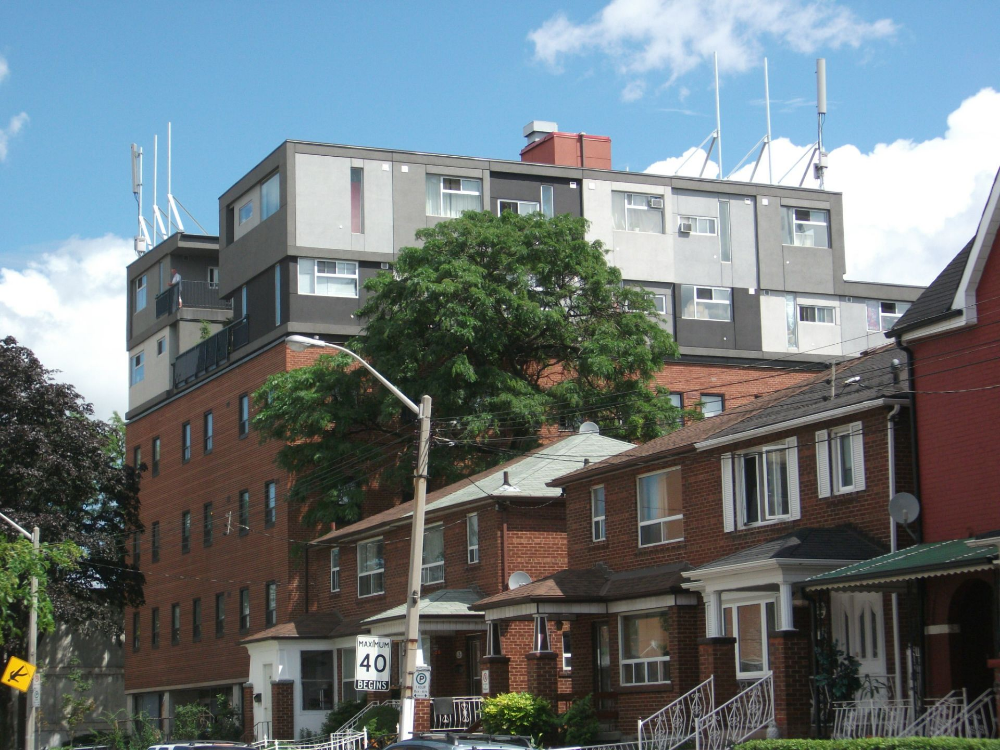Almost three years ago, St. Clare’s, a mid-sized non-profit housing developer, set out to add 22 affordable units to its property in Toronto’s Kensington Market.
The city is in a housing crisis, and St. Clare’s, which owns and operates 413 apartments, mostly in Toronto’s West End, has a proven record of building and operating housing geared to mixed-income clients.
But getting approval for those units required two years of jostling with the city’s planning department.
Andrea Adams, executive director at St. Clare’s, believes the city could be doing more to help non-profit developers bring affordable units to market.
In the entire city, only two non-profits are currently building new units, she said.
“One of them is Woodgreen and one of them is St. Clare’s — and that’s the 22 units that are out there,” says Adams. “It’s pathetically small in comparison to the need in the city.”
Toronto is in the midst of an affordable housing crisis. There are 96,828 people on the city’s social housing waitlist, with only 741 of those listed as “housed.”
Non-profit developers like St. Clare’s work to provide affordable housing that prioritizes long-term community needs over high profits.
“There seems to be, in North America, an understanding that it is appropriate to make profit from housing. But I don’t know that that is really an effective model, because it encourages poor long-term planning,” says Adams.
For-profit developers are motivated to maximize profits, says Adams. They are less interested in things like setting aside funds for repairs, because they can always sell the properties and move on to other projects.
St. Clare’s and other non-profit housing providers take the long view and focus on building housing that meets a variety of needs, from accommodating families at market rents to providing units for people who have experienced homelessness.
A non-profit developer, much like a for-profit developer, has an income and expenses, but the difference is not called “profit” and is not used to enrich executives and investors. Instead it’s called a “surplus” and is reinvested back into the building.
“If you want money spent efficiently, then the non-profit sector is where that will happen, because they don’t have the temptation to underspend on maintenance, which just creates a bigger maintenance problem later,” Adams says. “Any extra money is reinvested back into the sector.”
Patti Bell, executive director at Durham Region Non-Profit Housing Corporation, makes a similar point.
When for-profit companies develop affordable housing it isn’t a community asset, Bell says.
“They will come in and they could apply for the same money, and sometimes they can get it, and they build and they deliver those units. But the asset doesn’t belong to a community or a non-profit, it belongs to a single developer,” says Bell. After the end of their service agreement, private developers can choose to sell the property.
Even private developers have been unable to build enough units to meet Toronto’s housing demand, with the scarcity of units leading to increasing prices.
And because of these high rents, what is technically classified as “affordable” housing may still be too expensive for many low-income people.
“Affordable” housing, says Adams, is defined as anything at or below “average market rent,” an amount determined yearly by the Canada Mortgage and Housing Corporation. But as rents rise faster than incomes, fewer people can manage even “affordable” housing. This year, for the main downtown and West End areas of Toronto, the average market rent for a bachelor apartment was $1,064.
Often affordable housing is available at 80 per cent of that rate, which, at about $800, is still too expensive for those relying on income from Ontario Works or the Ontario Disability Support Program. A single person with no dependents receives about $700 per month on OW and about $1,200 on ODSP, with only a portion of that allocated towards shelter.
Adams says non-profits like St. Clare’s work to provide housing that even people on strictly limited incomes can manage.
Despite the long-term benefits of non-profit housing, building anything in Toronto means contending with the city’s often time-consuming planning process, a major stumbling block for non-profit developers.
The planning and approval process not only delays construction of new units but also pushes up the cost. The planning department, says Adams, needs to be more flexible when it comes to non-profits.
David Hulchanski, a professor of housing and community development at the University of Toronto, agrees.
“Cities need to do better, for all developers, frankly,” he says. “But… the non-profit sector is justified in making a case: ‘Hey give us some priority, we’re barely able to do what we’re doing, in terms of making it work financially, and if we succeed we’re going to house low-income people, we’re going to meet a social need.’”
Hulchanski points to a 1948 book by Humphrey Carver called Houses for Canadians, which reveals that Canadians have faced housing affordability issues for a long time, but in the past approached them entirely differently.
“[The book’s] last chapter is called ‘The Ultimate Housing Problem,’ and I have my students read it every year, because not a lot has changed,” says Hulchanski. The ultimate housing problem, he says, is that housing is expensive, and therefore subsidies are essential to building housing for lower-income people.
Canada had a social housing supply program from the 1950s to the 1990s, with about 20,000 non-profit housing units built per year, says Hulchanski.
“And now it’s just a trickle. And it’s a struggle for [an organization like] St. Clare’s to put together funding.”
Adams believes ideology is the main barrier to investing in non-profit housing.
The economic benefits are clear, she says, noting the high cost of temporary solutions. Toronto recently committed to spending more than $7.5 million on three tent-like, prefabricated structures that could accommodate 280 people.
By contrast, investing in permanent housing solutions, like those provided by non-profit developers, would produce long-term savings.
“If something financially makes sense, which is to invest in housing for homeless populations, why wouldn’t you do it? The only answer to that is ideology,” Adams says. “And it’s this belief that ideology, the private sector, the for-profit sector... is going to be a partner in the solution,” says Adams.
“We have been beating that drum for 20 years now. Guess what, it didn’t work.” ![]()
Read more: Housing
















Tyee Commenting Guidelines
Comments that violate guidelines risk being deleted, and violations may result in a temporary or permanent user ban. Maintain the spirit of good conversation to stay in the discussion.
*Please note The Tyee is not a forum for spreading misinformation about COVID-19, denying its existence or minimizing its risk to public health.
Do:
Do not: